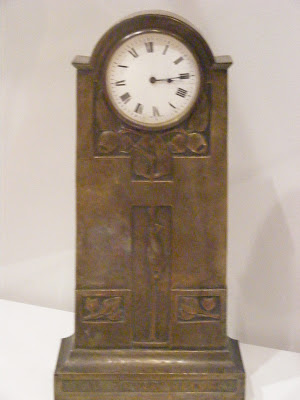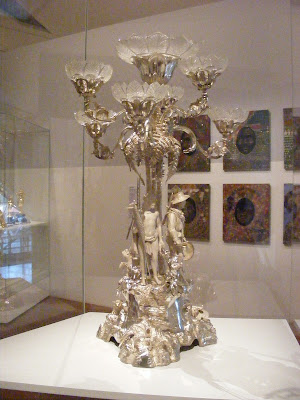So, I can share with you my Fifteen Fingers...and a few more. I hope you like some of them. Suggestion: look at the pictures. If you like them, read about them. If not, walk on past...
John Brack:
 |
| Two Typists |
 |
| Collins Street, 5pm |
 |
| The Bar |
Jon Campbell
 |
| So you wanna be a rock n roll star |
Stephen Bush
 |
| Hawkweed |
 |
| Rainbow Parrot Costume |
Jackson names many of her dresses, but the lighting didn't allow me to catch many of the names.
 |
| The Cricketers |
One of Australia's most famous paintings. I thought it quite eerie, but then there is a lot about Australia that strikes me that way, particularly the natural beauty. This picture "...of 'cricketers' under leaden skies in the wide open spaces of burning sands dramatises the 'outback'..."
I don't know who made/designed them.
I just liked them.
Pioneer of skincare Helena Rubinstein was one of the greatest female entrepreneurs of her time. Born in Poland she immigrated to Australia as a young woman and opened her first beauty salon in Melbounre in 1902, the beginning of her international beauty empire. She later became a voracious collector of jewellery and modern art of which she said 'I am a business woman, I am used to buying in bulk.' Dobell painter Rubinstein during her last visit to Australia in 1957 wearing a Balenciaga gown and magnificant jewels. Dobell's portrait emphasises Rubinstein's presence and dynamic personality which belied her tiny stature of four feet ten inches.
 |
| Helena Rubinstein, who told us "There are no ugly women, only lazy ones." |
 |
| The Red Hat a portrait of Lina Bryans - see next artist |
 |
| The Babe is Wise portrait of Jean Campbell, author of then recent novel by the same title. |
Rupert Bunny I not only liked this man's paintings, I loved his name. A long time ago my friend Vivien told me about having an artist do a piece reminiscent of Rupert Bear, a children's comic strip character, for her brother Rupert's birthday. Somehow Rupert Bunny just hopped up and twitched his furry nose at me.
 |
| Shrimp Fishers at St. Georges, c. 1910 Paris |
Bunny tended to use his former art student wife, Jeanne Morel, as his model and he apparently developed a liking for painting women next to water.
Such images of predominantly female figures engaged in leisurely pursuits, Bunny captured the elegance of the Edwardian age that was shattered by the outbreak of the First World War in 1914.
 |
| circa 1910, Melbourne |
 |
| The Pioneer |
This painting is considered one of the masterpieces of Australian art. We both stood long in front of it, trying to read the story it tells. I was struck by how much the pioneer theme echoed for me as an American in spite of the fact that the colours in this painting seem very Australian. It was apparently not uncommon - as I learned at the Immigration Museum - for women to be reluctant to leave Britain (or perhaps other homes as well) to immigrate to Australia. It was more a man's dream than a woman's. I guessed that in the first picture the woman is homesick. In the middle picture she has a child in her arms and their is a homestead in the distance instead of a tent. In the third, the man is visiting a grave, presumably her's. Bill noticed the town has grown up in the distance. This was painted three years followed the Federation of Australia in 1901.
It was this woman that initially caught my eye, and then the phrase 'quiet refinement and strength'. There is an aspirational phrase if I ever met one.
 |
| Madame Pfund |
There was an entire room of gold and silver artifacts, commissioned around the time of the gold rush by incredibly wealthy people...with perhaps questionable taste. Bill walked straight through but, magpie that I am, I had to at least look at a few. This one was pretty amazing. No idea what it was for - other than to proclaim the owner's wealth.
The sculptures around the base included an Aboriginal man,
a gold miner
and a shepherd. These pieces reminded me vaguely of all the gold nugget jewellery that was so popular (along with ostrich skin cowboy boots) in Oklahoma during the 1980's oil boom.
R.H. Rocke & Co, Manufacturer, John Mather, Decorator
 |
| This cabinet caused a stir at the 1880-1 Melbourne International Exhibition. |
Ugo Catani
 |
| Lovers' Walk, Mount Macedon |
Emma Minnie Boyd. Corner of a Drawing Room. Did you ever stand in front of a painting so wonderful that you wanted to move in and live in it? Where do I buy the decorating book that explained how this room got so cozy?
 |
| Circe gets me every time. |
 |
| This is a larger version of the one we saw (and I snapped) in Sydney. |
 |
| Flannel Flowers |
 |
| In the 18 inch seam, State Coal Mine, Wonthaggi |
 |
| The Cough...stone dust |
 |
| Kapunda Mines |
The stark nature of this reminds me of a book my parents had. It was a collection of ironic comics full of skinny naked people in hell. I thought it scary and sad, but I think my parents though it funny. I've no idea who it was by but I've always remembered it and though it gave a clue about my parents' life experience and outlook that I never quite understood.
I hope you've enjoyed this brief tour and that it will encourage you to go look at art more often, if you don't already. My photography in no way does these works justice. If you wish, I'm sure you can find most of them by artist and title in Google images. And you won't even need fifteen fingers to do that...















2 comments:
Shelley...these are just AMAZING...I love every one of these photos and feel like I have had a major tour...thanks and again happy birthday and many more.
Sandra
I stopped the longest on "The Pioneer" too. What a beautiful work. I enjoyed this post. Did not know this about Helena either.
Post a Comment